| 149th st pier | 8 x 8 | This small shelf layout depicts the Erie RR's 149th Street Pier in the early 1940s. This was a very busy spot for the Erie with the ferry arriving 3 times a day normally. Your task is pretty straight forward - unload and reload the car ferry as quickly as possible. There are a couple of storage yard tracks where you can sort your incoming cars or, store cars bound for the outbound ferry. |
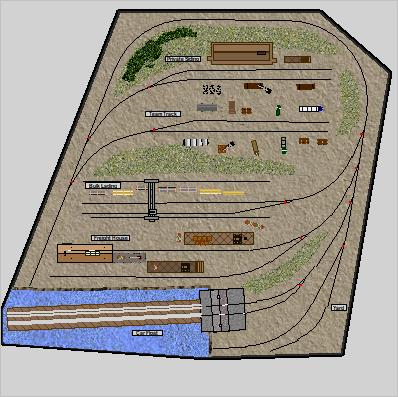 |
| 20th St.Yard - 1960 | 7 x 50 | This is another intense switching layout, inspired by a Swedish modeller named Stein Jr. who, due to his limited available space, concentrated on getting the maximum amount of switching into as realistic setting as possible. The time period modelled is the mid-1950s steam to diesel transition era in an eastern American city. The 20th Street Yard is a small 3 - 4 track space in a compact but busy industrial zone which features 20 small light manufacturers. We have simulated its location in a wider rail network by adding both an East and West divisional staging yard |
 |
| Agrium | 2 x 6 | This N scale layout by Byron Henderson packs a lot of operational action into a 4 x 10 layout. Mainline and Interchange lines, a small yard and lots of shunting about the landscape are yours to enjoy. |
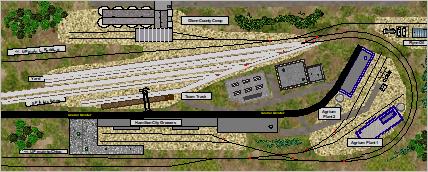 |
| Ajax Junction | 6 x 24 | The Ajax junction is an imaginary meeting point in central Pennsylvania between the PRR and the NYC in the late 1940s. Both railroads have customers in the town and work them, while they deliver cars to the interchange tracks for each other. |
 |
| Bar Branch | 10 x 38 | This shelf layout is based on MR's Tar Branch. On the east side of the layout, there are 2 Staging spurs loaded with cars bound for the 13 industries on this plan. The time period is the post WWII era where light industries are still going strong on this industrial branch. |
 |
| Bardsley | 3 x 17 | Bardsley is a mid-size town in the US north west, in the 1920s. This shelf plan contains a couple of runaround tracks and a small detachable yard. The main industry in this town is the cement plant but there is a good blend of other small and mid-sized industries to keep your switch crew busy. |
 |
| Bayport | 12 x 20 | This N Scale shelf switching layout was created by Bruce MacLeod 2019 with some assistance from the TrainPlayer crew. Bayport is a fictional ocean port on the US west coast. The time period would be anywhere from 1930 - 1950, in an era where steam is still dominant. There are several light and medium industries located near the busy pier area which also receives numerous loads of varied types. There are two hard working oil-fired switchers which handle all freight movements to area industries. They will rely heavily on the Wye and the run-around tracks to complete their chores in a timely manner. |
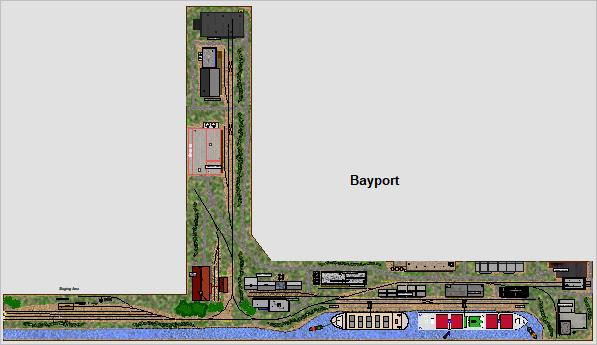 |
| Beckon Forth | 6 x 12 | Beckon Forth consists of a decent sized industrial zone divided by a river. This small 4 x 8 layout is set in the 1920s era and involves a day in the life of the local switch crew as they work their "turn" job and service all the customers on both sides of the river. |
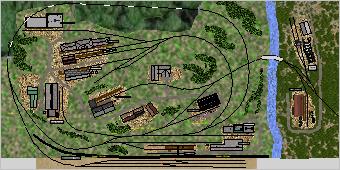 |
| Belmont Turn | 5 x 36 | This shelf layout, set in the steam to diesel transition era of the 1950s, focuses on a Swift Meat Packing Plant. There are also several other medium industries in town requiring regular service. All traffic enters and exits the modest town of Belmont from the staging yard on the east side. |
 |
Binbrook Spur |
2 x 35 | The fictional Binbrook Spur runs off of the CP main line in southwestern Ontario in the early 1960s. Its main customer is Dow Chemicals on the left side of this plan. Also, there is a good sized Fiberglas operation for ceiling tiles, a graphics company, food storage and food processors, a bottling plant, a dairy and an appliance manufacturer. For smaller businesses, there is even a Team Track area where they can receive/ship assorted goods, in either full or partial loads. In other words, Binbrook Spur is an active zone and profitable. |
 |
| Boughton | 2 x 12 | Boughton represents a typical British Railways Branchline in the late 1950's when coal was still king. The streets and many homes were still lit by coal gas produced locally. The branch terminus supports a small dairy which supplies bulk milk traffic for the metropolis, there is regular inbound coal traffic to keep the municipal gas works running and coke is produced at the gas works for shipment to other areas of the UK. The branch is operated by a dedicated engine with all goods traffic being interchanged with mainline trains at the nearby junction which is represented by a hidden fiddle yard. |
 |
| Brooklyn Terminal 1935 | 6 x 34 | This layout is loosely based on a design by Lance Mindheim for a shelf layout with a large big city presence. It represents one of the many small "pocket" railroads which operated in the docklands of Brooklyn, Newark, Queens and other oceanside ports in the vicinity of New York City in the mid-1930s. Steam was king and boxcars were the main railcar needed for service. Your daily work load will include loading/unloading the car ferry, servicing the pier locations as well as handling the switching for all the industries on your patch. Locate the various runarounds and use them wisely. You can use any empty track to temporarily store cars while performing your switching tasks. |
 |
| Browning Street Zone | 3 x 28 | Browning Street Zone is a small modular layout with an extension for added staging. It would be a good layout to practice your switching skills. |
 |
| Burnt Cabin | 2 x 19 | This modular layout is based on Robert Pethoud's Fall Creek Branch which appeared in the March 2016 issue of Model Railroader. This plan incorporates a TimeSaver puzzle with some more generous space allotments. The time period is early 1900's when steam is KING and small towns lived or died based on rail connections. All trains start and finish at the East Staging and run as turns to the Burnt Cabin Yard. The goal is to end up with your engine at the front of your train and the caboose at the rear of the train in each direction. |
 |
Caspar Creek Lumber Co. |
3 x 16 | This shelf layout is based on a fictional typical narrow gauged lumber railroad called the Casper Creek Lumber Co. which operated in northern California in the early 1900s. Not far from the Staging Yard, there was an Interchange the North West Pacific RR from whence came most of the Company's supplies and which was their access to the larger Pacific north west marketplace. The Casper Creek has 2 well maintained engines - an 0-4-0 steamer and a 2 truck Shay to handle the demand. The company went bankrupt during the 1930s. |
 |
| Cedar Creek Industrial Park | 4 x 38 | Cedar Creek is a mid-sized city on this branch line which sees daily switch services from either east or west ends. Your SW 9 local tramp will start its first trip into town, travelling westbound while serving the industries in the Park. On its eastbound return from West Yard, it will again switch all industries and continue to East Yard. This cycle repeats with different cars on alternate days from Monday to Friday. |
 |
Central City RR |
10 x 17 | This Central City RR shelf layout plan which is set in the early 1950s, depicts a small inner city yard which services a few nearby industries, with the largest of these being the Dixon Appliance company. You will be using the Wye track frequently to complete your various switching moves. There is a switchback track which services Jenkins Metal which may become a real headache. |
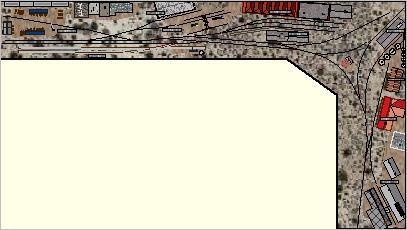 |
| Centralia Industrial | 9 x 19 | Centralia Industrial is a small shelf layout which is set in the early 1970s early in any mid-sized American city in the mid-west. On this stub district, there are 12 light industries for the local switching crew to service twice daily. |
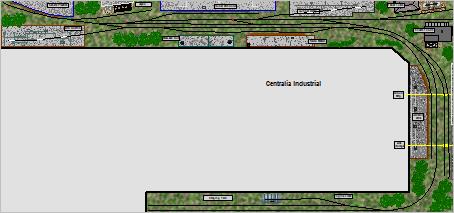 |
| Chexton Industrial Estate | 3 x 28 | This Estate is a fictional commercial zone in a large metropolitan area in the UK which is still being served by rail in the early 1960s. This module displays some light industries which generate suitable mixed goods traffic. This zone is being serviced by a small BR shunter located in the East Yard. As driver, you may need to put together your train from the labeled cars standing on the East Yard roads. Once you head out, you will also need to pull any cars which are labeled. |
 |
| City Switching | 23 x 48 | City Switching is a shelf layout which is based on a track plan by Chris Atkins of the track arrangement at Lewiston Idaho. The artwork was completed by Mark Johnson in 2011. Lewiston has several large grain mills /elevators and food processing/ warehousing facilities within its boundaries along with a decent mixture of light manufacturing businesses. |
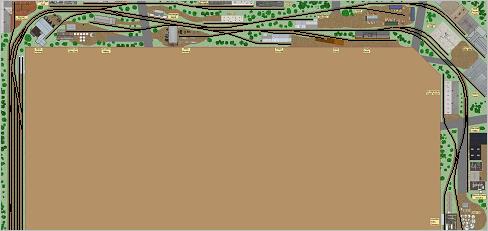 |
| Clarke Point Industrial Zone | 13 x 24 | Clarke Point Industrial Zone is typical of a mid-sized, mid-west American city with a variety of heavy and light industries clustered together. With this plan, we have brought two industrial areas together on the one plan to add to your switching operations from one central staging area. The A Zone has mixed medium and light industries with rail needs, while the B Zone to the north has the larger industries with their own requirements for bulk services. With the limited yard and runaround space, you will need to plan your train movements carefully. |
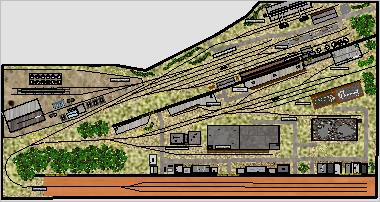 |
| Cline Street | 5 x 38 | Cline Street is a shelf layout based upon a fictional modern era industrial zone in a typical large city. There are some large industries but traffic patterns are not heavy with most receiving their raw material by rail but shipping their end goods by track. There is a small staging area on the south east where most of the traffic originates. The west end of the main line also serves as an industry with some bridge traffic flowing outbound over these rails. |
 |
| Coeur d'Alene Industrial Park | 9 x 17 | Coeur d'Alene Industrial Park by Mark Johnson is a fictional, shelf style layout which captures the spirit of a busy industrial park found in many mid-western states. The industries on this plan are also typical of a granger based economy with some light industry. |
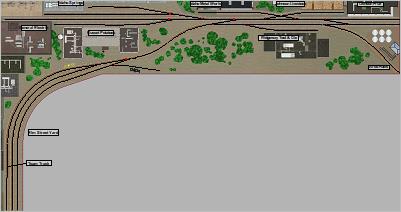 |
Cold Harbour |
7 x 13 | Cold Harbour is a fictional ocean port on the Canadian west coast in the late 1940s. Tucked up against the mountains, the town depends on a daily car float to bring in necessary supplies and goods and to deliver local products to distant markets. The main industries in the town are a seafood plant, cannery, 2 piers, a storage warehouse, a dairy and other businesses which provide services to the nearby lumbering and mining companies. You will be operating a small diesel which is kept relatively busy most days. |
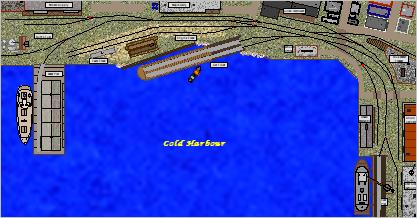 |
| Cranston Industrial | 4 x 8 | The Cranston Industrial is also a 4 x 8 plan but done in N scale. You can visually see how much more action and operations can be applied to this common footprint size. This plan includes a small yard, an Interchange, a major flour mill and a handful of other prospering industries for you to service. |
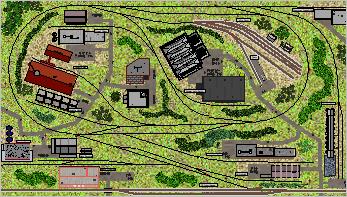 |
| Crawford Rd | 3 x 32 | Crawford Road is a small but busy industrial zone in a typical North American urban area. This shelf layout is set in the 1960s era and the industries are typical of that time period - some light industrial and food services. |
 |
| Dearborn Industrial Park | 25 x 26 | The Dearborn Industrial Park is a shelf type layout, set in the modern era on a Class 1 railroad. The goal of this layout is to improve your switching skills with several trailing point and facing point switches with only one runaround track to assist your moves. |
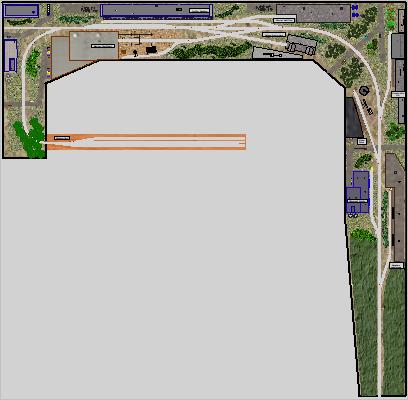 |
| Denton & Petuluma RR | 6 x 6 | Denton & Petuluma RR is a 5X8 plan which features a double track oval with a small attached yard and an interchange. The town of Denton also boasts a few good sized industries for you to service. |
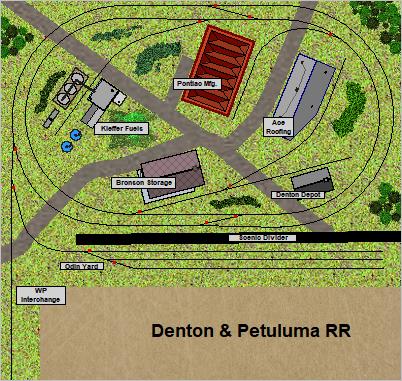 |
Dolly Varden Line |
6 x 40 | The Dolly Varden Mine Railway was an 18 mile long, 3 foot narrow gauge railway built in rugged mountains of Northern British Columbia at the end of WW1. It serviced the Dolly Varden Mine, containing some of the richest deposits of silver ore ever found. The mine consisted of a camp at the top of the railroad with an ore tipple and a powerhouse, and ended on a wharf and a large ore bunker on the shores of Alice Arm. The line also supported a small lumbering operation in the surrounding mountain sides. DVMR's history is short, having only existed from 1917 to its eventual closure in 1921. This plan is based on the Johnson-Jaeger design from MR in 2016, except for the addition of the Staging area and the lumber camp |
 |
| Duncan | 6 x 8 | Byron Henderson designed this HO 6 x 8 "donut" shaped plan to show that some decent operations and passenger service could be achieved in this size range. Duncan is a fictional small mid-west town which relies heavily on rail service to provide the resources its' industries need. The time period is the 1930s steam era where small and medium businesses were struggling to survive the Great Depression. |
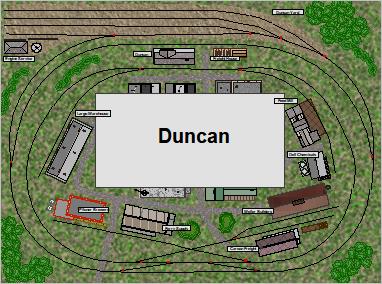 |
Easton-Weston |
2 x 24 | Easton-Weston is a short line which connects the small town of Easton with a Class 1 railroad at Weston. The period is the mid 1940's and the railroad is suffering from the growth of road traffic. Rail Traffic to and from Easton and Middleton originates from a Staging Area close to the main line at Weston. Traffic is extremely light as the railroad is in decline and we will only be handling about five inbound and five outbound cars each day. This is a Tutorial Layout specifically designed for use with the Step by Step Guide in our Advanced Ops for the Designer guide. |
 |
| Eastridge | 7 x 12 | Eastridge, which features plenty of operations, is based on a Byron Henderson N scale plan for a 4 x 8 layout set in the mid-1930s era. While this looks like a compact layout, getting from the Yard to the coal mine is a long haul. There are 9 customer sites split between the 2 major towns - Weston and Eastridge. You will need to use your runaround tracks wisely to minimise the switch moves you will need to make to complete your switch lists. |
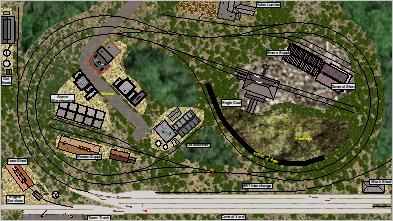 |
| Echo Jct | 9 x 24 | Echo Jct. is part of an NYC branch which terminates at a junction point with the Pennsylvania RR in the early 1940s. It has its own small yard, engine facilities including a small roundhouse. The town also features a few local customers who depend on good rail service and connections to get their products to market. The PRR has track rights to all industries in Echo Jct. |
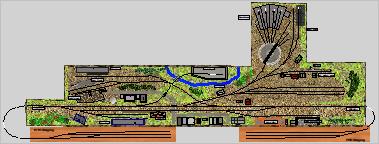 |
| Freezer Burn | 2 x 12 | This plan was inspired by CJ Freezer's Track Plans for Various Locations by PECO, used with permission [July 2012]. It is based on his Plan 30 for a terminal branch station in central England in the 1920s era. Like many of Freezer's plans the focus is on operating some goods and passenger trains in some very restricted spaces. |
 |
| Grove Bay Jct | 5 x 25 | Grove Bay Jct. is an imagined connection between the Milwaukee Road and the Wisconsin Southern. The Grove Bay Turn does a daily run into town to switch the local industries and to service the interchange with the Wisconsin Southern. The main traffic generator is the United Co-op Mill which ships 16 loads daily. |
 |
| Hartling Branch | 3 x 39 | This small plan called Hartling is inspired John Flann's Hintock from the Railway Modeller magazine in 2011. It represents a typical but fictional small English town in the early 1920s. There is a daily passenger train going up to the next market town. To keep the local shunter busy, there is also a brewery, dairy and coal merchant to service along with some smaller industries ranging from a wholesale green grocer to a couple of furniture and cabinet makers. Just to the west of the town there is a still active stone quarry which ships limestone to larger markets. |
 |
| Hazelton PA | 5 x 9 | Hazelton PA is 4 X 8 track design by the famed John Armstrong. It has sharp curves but does have a long runaround track,an interchange and a small freight yard along with a handful of light industries to service. |
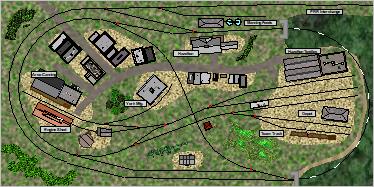 |
| Hiawatha Ave. 2009 | 4 x 128 | This is the protoypical configuration of the track work and the industries located along Hiawatha Ave., Minneapolis, MN. in 2009. A few of the grain elevators are now empty and no longer rail served, but there are still 2 large mills to switch and a few other smaller industries as well. The typical "mill job" would see the switcher arrive at the west side from the main yard 2 miles distant. It would spot 20 - 30 hoppers at the mills and pull about the same number of loaded hoppers. At the same time, there were always some other cars to pull and spot at the other industries. |
 |
| Inglenook Sidings | 1 x 3 | Inglenook Sidings is based on the classic UK shunting puzzle. -- The original puzzle was designed by Alan Wright in the 1950's. -- You must pull all three cars from the Siding and set down the three marked cars. -- Each car must be inserted into the train in the marked sequence. -- Regulations state that your engine cannot enter the tunnel portal during shunting. -- The number of possible different five car trains that can be assembled is 6,720. -- The number of different arrangement of cars that can occur on the layout is 40,320. |
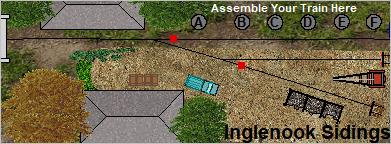 |
| IOTA | 2 x 9 | This version of Iota closely follows Andrew Martin's layout of the same name, with the exception that 2 staging yards were added to add "bridge traffic" and to enhance OPS capability. The Peddler comes into Iota and must work through its cut of cars needing to be spotted or pulled. |
 |
| Iron Bridge | 10 x 13 | Iron Bridge is a small fictional seaport town with a coal dock and a fuel depot to service on a daily basis. As well there are a couple of marine type industries to switch. You will need to use the Staging yard on the plan to sort your train before delivering the cars per their routing labels. The track labels for the industry sites are laid out in simple alphabetical order from east to west to help you sort your train. |
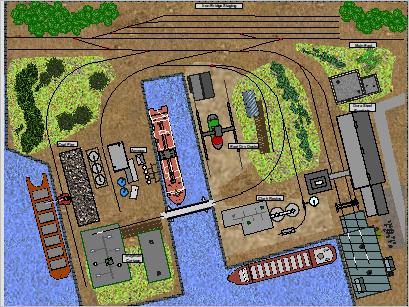 |
| Ironton Branch | 6 x 12 | The Ironton Branch is based on the Linn Westcott Plan - L10 Pembroke, Meadvale & Ironton RR. This branch has a small yard with a connection to an Interchange. With its small switch engine, it also services a few local industries. The time period is the mid-1930s. |
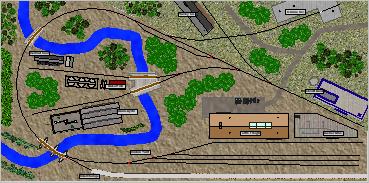 |
| Ithaca NY | 3 x 35 | This is an "imagined" industrial complex located near this mid-sized town,Ithaca, in New York state. It is served by a short line railroad which receives cars from a nearby interchange [off plan]. The time period is the 1960 - 1980s modern era. There are several industries to serve, most of them with either facing point or trailing point drops. But there is one switchback link which may prove a bit of a challenge. |
 |
| Jamestown | 16 x 18 | This is another adaptation of a plan from Lance Mindheim which appeared in the Model Railroad Planning annual for 2015. This is a modern era plan set in a fictional south eastern US urban centre, we call Jamestown. Although there are only 8 industries on this plan, there are 19 spots which need to be switched. So, the action is intense for such a small shelf space. |
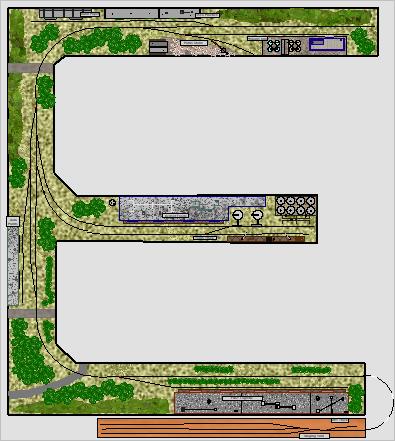 |
| Judson Valley | 6 x 39 | Judson Valley is a busy "bridge" hot spot at the mid-point in a large division of a class 1 railroad in the US north east in the modern era. Judson Valley has a small "sorting yard" from which it services its varied customers. A significant amount of their rail traffic involves moving cars both east and west to the larger division yards. |
 |
| keenley_ao | 6 x 55 | Keenley is a fictional mid-west industrial city during the late 1950s. It has several smallto medium sized light industries with most of them focused on manufacturing, chemical and food processing. The Staging yard tracks represent the typical daily traffic this district would generate. The action keeps the local crew busy for much of the day |
 |
LAJ yard job |
5 x 29 | This is actual trackage of the Los Angeles Junction [LAJ] Railway which is a neutral switching railroad that receives interchange traffic from the BNSF and Union Pacific Railroads. The LAJ services many small and medium business customers in Vernon, close to the downtown of Los Angeles. |
 |
| Little Boxes | 1 x 5 | Little Boxes is based on the switching puzzle Switchman Sharpener which appeared in Bruce Chubb's 'How to Operate your Model Railroad'. This version has been adapted to demonstrate how a very small layout can still function effectively using the TrainPlayer Advanced Ops system. The Yardmaster has sent the local switcher down to the Freight Warehouse with two cars to spot and instructions to pull two of the three cars already standing at the warehouse. Traffic is very heavy and the switcher can only work within the confines of the warehouse tracks. The unmarked car can be moved for access but must be returned to its original spot. |
 |
| Lockport | 2 x 11 | Lockport is a busy mid-sized centre on the US north east coast in the 1950s era. This is an economy focused on fish with processing plants and a cannery. As well there are a couple of smaller, related industries to service as well. Your SW1 is initially located in the Yard [Y] with its 3 idler cars for accessing the car float. |
 |
| Lyme Ridge, Hercules & Portland RR | 5 x 8 | Lyme Ridge, Hercules & Portland RR is another 4 x 8 layout plan with an expansion board used for the yard. The main focus is on the cement plant, but you can practice "meets" between the passenger train and the local peddlers. |
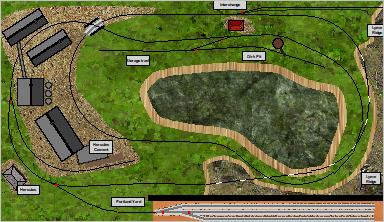 |
| Macklin Street sub | 5 x 14 | This shelf type layout is based in the modern era and represents a busy industrial district on the US west coast. The JP short line operates the Sub which runs off a Class 1 railroad. Macklin St. features a variety of medium industries that will add to the challenge of your assignment. |
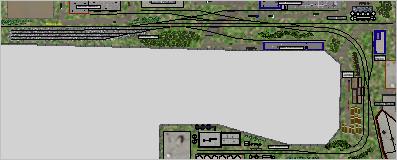 |
| Madras | 3 x 12 | Madras' industrial park contains only 6 industries with 7 drop spots. But it can be a real challenge to complete each switch list since there is only one runaround track. Careful planning is essential. |
 |
| Marlboro Branch | 4 x 19 | The Marlboro Branch is a small shelf plan which focuses on 6 industries and their needs. Both the Ferly Transload and Exxon Plastics would see in/out traffic during the day. The other 4 industries have seasonal peaks and valleys in their rail traffic. Your SW 1500 should make quick work of the tasks for this short branch. |
 |
| Marplain Terminal | 2 x 14 | Marplain Crossing first appeared in our Layouts 2014 UK World folder. It was set up for our original version of TrainPlayer OPS. Here, this N scale switching shelf layout is now converted to our TrainPlayer Advanced Operations and called Marplain Terminal. Marplain Terminal, which is set in the late 1950s, represents a small mixed industrial estate, served by a nearby division yard. |
 |
| Maryland Central | 3 x 5 | Maryland Central is 4 x 8 HO layout designed with operational potential in mind - a small yard, an interchange and some industries including a cement plant, and two food processors. |
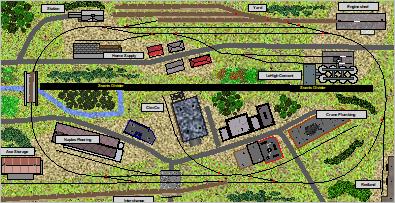 |
| Meafurst | 2 x 18 | This modular layout represents a branch off the main Santa Fe line in the early 1960s. It represents a mid-sized town in the US northwest with a few small and medium light industries which are still being served by rail. There are staging yards at both ends of the layout and the local trains also carry a small amount of bridge traffic between the two yards. |  |
| Meldrum | 5 x 9 | Meldrum is another innovative Byron Henderson 4 x 8 plan which provides plenty of switching action and is guaranteed to hold your interest for a long time. It includes a small yard, an interchange and several suitable industries requiring rail service. |
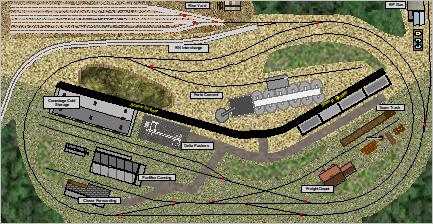 |
| Minnesota Transfer Railway | 4 x 23 | This shelf type layout is inspired by the late Stein Rypern's 32 St. Yard. Stein was a big believer in providing lots of OPS in a small space. SteinJR, as Rypern was known on-line, provided many practical and sensible designs on bulletin boards in Europe and also for Model Railroader and the Layout Design SIG. The Minnesota Transfer Railway was exactly that. It serviced a few customers while mainly spending its efforts forwarding cars along their journey once they reached the MTR's home turf |
 |
| Mount Brydges Branch | 2 x 31 | The Mount Brydges Branch is a fictitious line off of the New York Central RR in upstate New York. It services several mixed light industries and a small sorting yard in the town. The Branch has connections to the east for New York City and, in the west to routes heading to Chicago. There is daily fast freight in each direction which stops to set out and pick up cars at Elwood Yard. Once the through train has completed its run, the local Blue Liner is tasked to service all the industries in the Mount Brydges area, these include a small interchange on the west side of town which handles some regular traffic to the Penn Central RR. Passenger service has ended but local freight traffic is still robust. An engine for the through trains can be found in in the appropriate staging area. All local work is handled by the Blue Liner which is based in Elwood Yard. Your first task is to exchange cars between Elwood Yard and the Penn Central Interchange. You are also responsible for running a daily fast freight in each direction and should stop to set out and pick up cars at Elwood Yard. Once each through train has completed its run you should generate a new switchlist for the local train to service all the industries in the Mount Brydges area. An engine for the through trains can be found in in the appropriate staging area. All local work is handled by the Blue Liner which operates to and from Elwood Yard. The local is not permitted to enter the staging areas. Remember to use the yard and runaround to set up any facing point moves in the west of town. |
 |
| Ogden & Northern | 2 x 25 | Layout Ogden & Northern is a bookshelf plan layout which is more suited to the shorter wheelbased steam era freight cars and smaller engines. It includes a mainline and a branch section along with a yard and several industries. There are several trailing point and facing point moves to make to shunt the freight about. Good practice for your switching skills. |
 |
| Palm Spur | 8 x 12 | Palm Spur is a short branch on the CSX in present day, central Florida. With this grouping of warehouses, team track and transload facilities, most industries have multiple "spots" where cars are to be dropped. So, while this shelf layout looks simple enough, there are some interesting and challenging Ops here. |
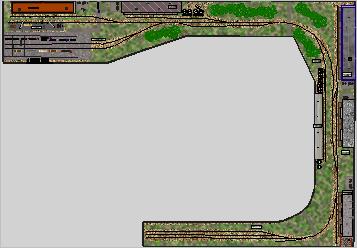 |
| Pembroke Meadvale Inkton | 5 x 11 | Pembroke Meadvale Inkton is a basic 4 x 8 layout design with a small yard, an Interchange and a few industries on which to practice your switching skills. |
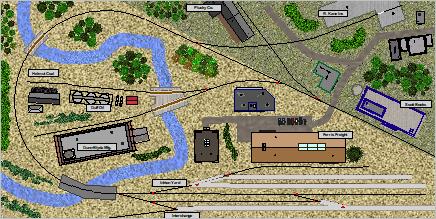 |
| Port Arthur | 11 x 15 | Port Arthur is a fictional seaport located on the American west coast. It has its own small short line the Port Arthur Terminal Railroad [PATR] which services all the town's industries which are focused on fish/seafood business and some exporting of flour and other products via its 2 busy piers. The PATR uses a small GE 50 ton diesel, nicknamed "The Growler" due to its noisy motor. The 50 tonner is ideal because of its light weight and its ability to get into some tight spots while switching. There are 2 nasty switchback moves required to service Monarch Flour, Connacher Freight locations and the 2 Piers which require some careful pre-planning. Also, there is only one runaround track to assist you along the way. |
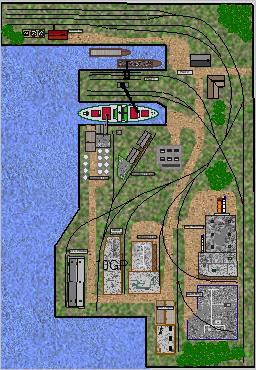 |
| Progressive Rail - Airlake MN | 4 x 18 | Progressive Rail [PGR], a shortline serving northern Minnesota, services all of the major industries within this business park in AirLake MN. Most of the industries are focused on natural resource and petroleum based production and generate regular traffic daily for both CP and the PGR. This modular layout is based on a George Baustert design of the Progressive Rail Terminal. This current version includes a runaround track which the prototype does NOT have and, it also includes a designated Interchange track to the CPR within the layout itself. Normally, the CP would drop the transfer cars on their interchange track and the PGR would fetch them. We've decided to add that movement as a separate PGR train. |
 |
| Red Wing Line | 3 x 5 | Red Wing Line is another innovative Byron Henderson design. Byron took the HO scaled Red Wing Mill layout design, converted it to N scale and then added elements to make for some interesting operations on a small plan. Included on this plan are 2 runaround tracks to make your switching tasks go quickly. |
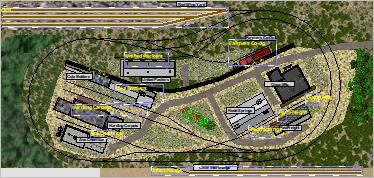 |
| Reedley CA | 5 x 10 | Reedley CA is 4 x 8 design by Byron Henderson which features a double track and still has great scenery potential, a small yard, an engine shed, an interchange and a few industries to keep the rails shiny. |
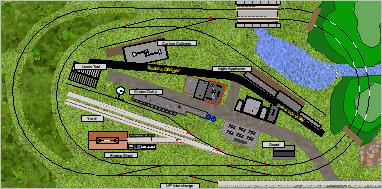 |
| Rimfire & Latigo RR | 3 x 6 | This 4 x 8 plan by Dave Meek, features an On3 short line in the mountains of Colorado. Rimfire is a camp town based on a silver mine, while Lattigo is a town in the lowlands which is home to a few local industries. There is an unseen "interchange" with the RGS which is both the major source of supplies for the R&L and its clients, and it also gives the locals access to the broader export markets for their finished goods and raw materials. |
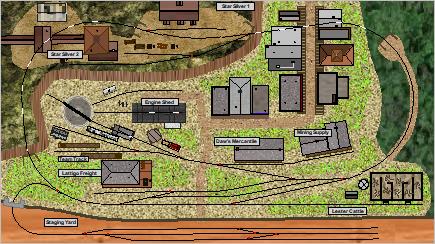 |
| River Oaks branch | 19 x 20 | The River Oaks branch is set in the US mid-west in the early 1950s time frame. The branch primarily serves the Union Packers plant and a Deere Farm Equipment factory. But it also includes a sawmill operation, a lumber supply depot, a fuel dealer, a feed mill and a farmer's warehouse. There is a small classification / staging yard to the south side and it has a typical road switcher which handles the daily runs to service the clients. You may decide to service Union Packers first because it has the highest volume of cars for pick up and spots. There are a couple of runaround tracks, use them wisely. On the outbound journey the train is led by the engine. For the return the tender leads the engine as it pulls its drag home. |
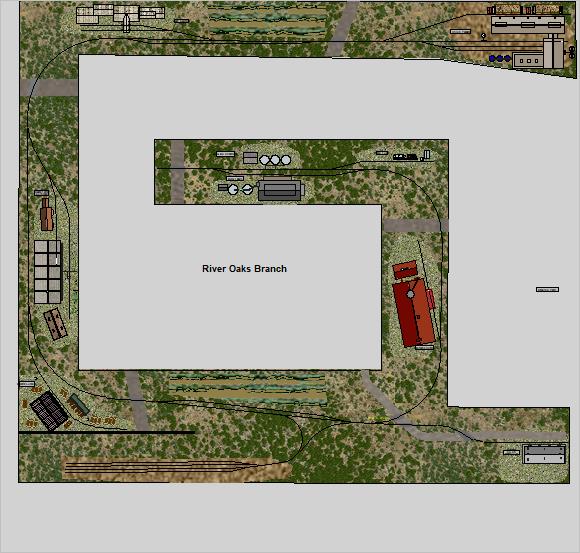 |
| Riverhead Siding | 11 x 47 | Although primarily known for its high profile passenger service to New York City, the Long Island Railroad in the 1930- 1950 era depicted here, also had a modestly successful freight business which serviced the many small and mid sized towns on Long Island. Riverhead was one typical town which boasted a good mix of agriculturally based and light manufacturing based businesses which required frequent rail service to meet their growing customer markets. There are 4 mixed trains which include a combine car for parcel and passenger service. This train passes through Riverhead four times per week schedule - 2 eastbound and 2 westbound on alternating week days. |
 |
| Sacramento R Street 1950s | 3 x 21 | R Street was a major Sacramento industrial and railway corridor from the late 1890s through to that late 1960s. This shelf layout depicts only a portion of that busy roadway. For the 1950s time era, the main class 1 railroads operating along R street were the Southern Pacific and Western Pacific. The WP had significant terminal facilities on the north west part of the street including freight houses, packing sheds leased to produce shippers, a scale house, and a team track area with an overhead 20-ton capacity gantry crane. While the SP served the businesses mostly on the southern side of the street. Both railroads interchanged traffic with each other on a couple of transfer tracks on R Street between 4th and 7th Streets Eventually the Union Pacific bought out both the WP (1983) and SP (1996) railroads, and rail services were mostly gone from R Street area by the late 1980s. |
 |
| Sandstrom Park | 3 x 44 | This shelf layout is set in the modern era and it represents a business industrial park in the east end of Toronto, Ontario. There are a couple of runarounds to assist you in your switching tasks. Use them wisely. |
 |
| Shamrock Ave. Fort Worth, TX | 20 x 25 | Forth Worth RR, a shortliner, services this busy little spur in downtown Fort Worth. BN drops cars intended for Shamrock Ave. on track BN1 and BN2. The FWRR switches out this industrial spur twice a week. This plan is set in the post-2005 era with longer wheelbase railcars. |
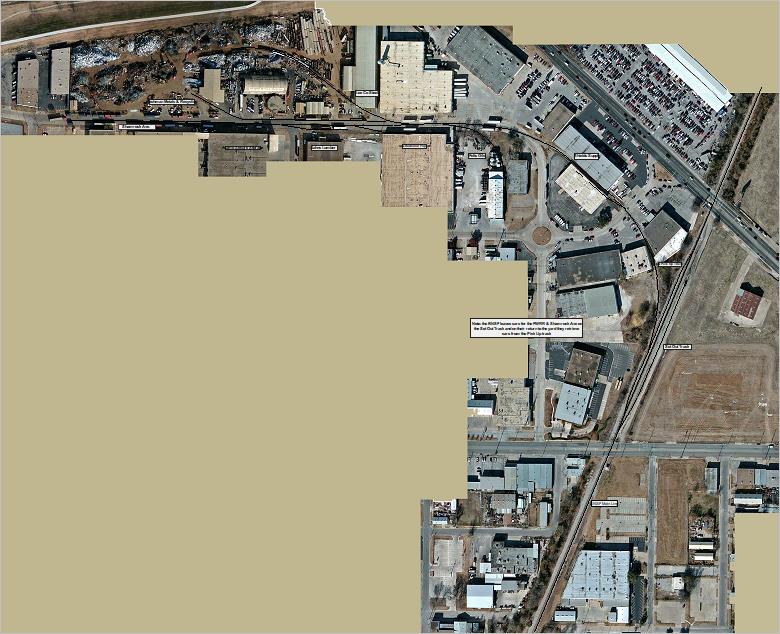 |
| South Fork Lumber Co. | 5 x 7 | South Fork Lumber Co. - The focus on this narrow gauge [HOn3] plan is the interaction between the lumber camp and the sawmill. The Colorado Southern RR is the main carrier with a larger town, north of South Fork. It is the source for most of the supplies brought into town. The CS is also a destination for all finished timber, headed to other markets. To be successful on this plan, you will need to use both the runaround and the switchback tracks wisely. |
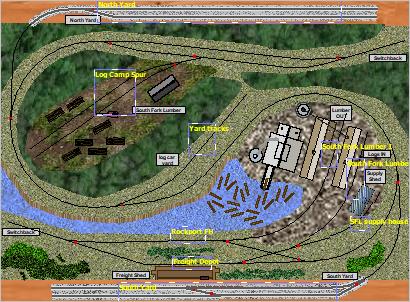 |
| SP Clinton Branch - Houston | 5 x 45 | This SP Clinton Branch - Houston shelf plan is inspired by Greg Johnson's layout as seen in the Layout Design Journal of winter 2012. The Clinton Branch switching line has a varied industrial base which includes oil refineries, chemical plants, heavy manufacturing, cotton compresses, warehouses, grain elevators, oil tool manufacturing. The layout features a main yard at its east end. At its mid-point there is an active interchange connection with the Houston Belt Terminal RR which provides plenty of new cars and destinations for off-line shipments. You have 2 GP9s available. You can use one or both to complete your switch list. |
 |
| Spotsville | 6 x 25 | Spotsville is a fictional shelf layout with a "hidden" staging yard on the south east side. There are only 3 rail served industries in this industrial zone BUT there are 21 defined spots where these customers want set outs and pick ups placed. NOTES: - Starting at Cadburys, all track labels for the defined spots to be switched are laid out in alphabetical order [a - h]. - There are a couple of run-around tracks to help you complete your task. Your task is running the daily peddler which services these 3 industries. |
 |
| Stearns | 7 x 16 | Stearns is modular layout representing a fictional short line branch off the main C&O line in the early 1960s. It depicts a mid-sized town in the eastern US with a number of small and medium light industries which are still being served by rail in this time period. There are 2 staging yards at either end of the layout which represent off plan customers / suppliers. The 2 staging yards also provide a good amount of bridge traffic for cars moving in either direction |
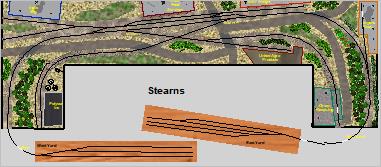 |
| Switching Black Label Brewery | 6 x 23 | This plan is an adaptation from Model Railroader's article - Industries You Can Model: Brewery. The plan depicts the various buildings which make up a typical large scale brewery. There is a separate Coal House to receive the fuel to power the other buildings. The mid-sized grain elevator stores various grains, hops and malts used to make ale. A corn syrup facility provides the color and sweetener for the ale. The heart of the operation though is the brew house and the bottling plant/warehouse. There are specific tracks dedicated to each of these specialized buildings which keeps the brewery switcher busy shunting cars onto and off of the property all day long. |
 |
| Taylorville | 9 x 16 | Taylorville is a shelf layout depicting a small mid-west town with a small staging yard and several agrarian based businesses and some light manufacturing industries for the local switcher to service. The runaround limits your moves so careful planning is essential. |
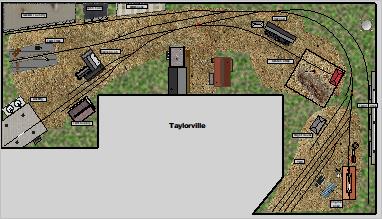 |
| Templeton | 3 x 35 | Templeton is an operations intensive shelf layout which is loosely based on Byron Henderson's Yuba City plan found on his website here: http://www.layoutvision.com/gallery/. This small plan has 12 industry spots to service with a mixture of facing and trailing point switches. There is one runaround track to the east of the layout to assist you with your work assignments. |
 |
| John Allen's Timesaver | 1 x 4 | John Allen's Timesaver This layout is based on the classic Timesaver game invented by the late John Allen. The instructions are simple but completing the task is not. Exchange the two inbound cars which are attached to the engine with the two outbound cars which are displaying labels. You can move any of the other cars to improve your access to the spurs but you will need to return these cars to their original spots before you can complete the task. |
 |
| Toledo Centre Branch | 6 x 21 | This is a complex and challenging switching layout on a shelf plan inspired by the Toledo plan from Model Railroader in 2014. There is a cluster of mid-sized industries in Toledo's central district which, due to space constraints, are labor intensive to switch. But business is good and profitable. So a couple of small switch engines tend to the needs of these customers and run out to a nearby larger yard to exchange cars. There are a couple of switchbacks which will require careful consideration when switching. There are also a couple of useful runaround tracks to assist you. Plan carefully when setting up your runs. |
 |
| UP Council Bluffs Subdivision | 4 x 31 | This modern day virtual layout reflects the track work and local industries on the UP's Council Bluffs Iowa branch. There are a few large volume industries - the grain mill, the cement plant, the auto plant and the transload area which are handled by the road switchers in block movements. There are also a few smaller customers and a team track area which handles individual car movements. |
 |
| UP Switch Challenge | 1 x 10 | This shelf layout, based on a design by Andrew Martin, represents a common site in many North American cities and towns, namely a small industrial area with some rail served industries and limited track space. Careful planning will be required to complete the various switch moves here. |
 |
| Ventnor | 2 x 27 | Ventnor is the fictional terminus of a branch line in the Midlands of England in the 1920s era. There is a daily passenger train which arrives early in the day. As well there are a few rail served industries along the route which generate some daily traffic for the local shunter. |
 |
| Warwick | 6 x 49 | Warwick is a typical small north east city. Local industries are based on light manufacturing and agriculture. In the late 1950s, there is still sufficient local traffic to send out a daily peddler to spot new cars and pull out loads and empties bound for distant customers. On the far left side, there is an interchange track to the Penn Central lines. |
 |
| Waterloo spur | 6 x 25 | The Waterloo Spur,as depicted here,is a fictional extension off the CN mainline which runs through the area. The time period is the early 1950s. There are several local light industries and a small grain elevator along the line for you to switch on a daily basis. Most of the pick- ups will be returned to Brenner Yard [BY] or Carr Yard [CY] before being routed elsewhere. On the east side of the layout, there is also a interchange connection [GEX] to the Brampton Branch which will also require your attention. |
 |
| Weatherbee St - Detroit MI | 5 x 67 | This industrial spur is located nearby Weatherbee Street in Detroit Michigan. There are 5 active customers - PDI plastic pellet transloading spot, Pillsbury, a scrap yard, Detroit Mill Supply and a building supply yard. This spur is switched twice weekly by the shortline DCRR. All incoming and outgoing cars are routed to the Staging Yard The GTW also has track rights on this sub and it runs a weekly train to nearby industries like the plastics plant and the salvage dealer. |
 |
| Willow Rd. Yard | 4 x 22 | This shelf plan of Willow Rd. yard highlights the Ops potential that can be achieved on a small layout. There are two large customers - Burns Meat Packers and Porter Ag. Chemicals, along with a few other industries. As well, there is an active Interchange and a busy industrial staging yard. A tired S1 switcher will be your work horse for this industrial zone. |
 |
| Worcester Street | 2 x 29 | Worcester Street is a modular layout representing a very industry intense zone in a modern, larger American city. Your assigned cars will be found at the Worcester St. Yard on the east side. |
 |
| WP San Jose CA | 6 x 70 | San Jose CA is California's third largest city. San Jose in the early 1960s, was transitioning from an agricultural based economy to a modern industrial manufacturing, high tech one. What is depicted is the Western Pacific's small Williams Yard, some of the Seventh Street spurs along with the interchange with the Southern Pacific. There is one switch engine on the WP to handle the traffic to the various sites. |
 |
| Zone 4 Lubbock Tx | 4 x 25 | This shelf layout is based on the CLIC chart for a small area of Lubbock Texas in the late 1930's era. The largest customer is West Texas Compress with fairly regular daily traffic. This zone is handled by a small 0-6-2 switcher running out of the main yard a few miles to the west. |
 |